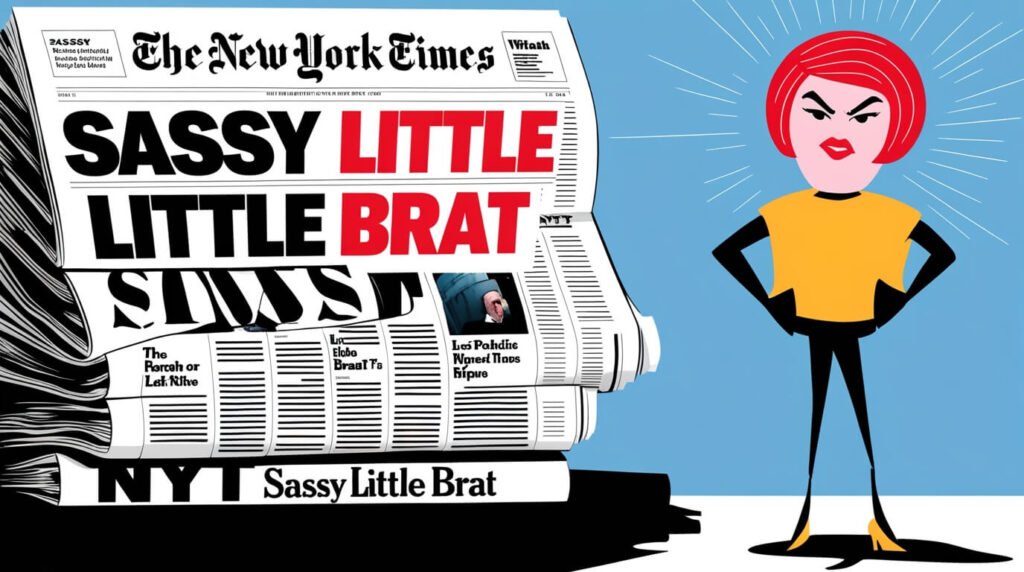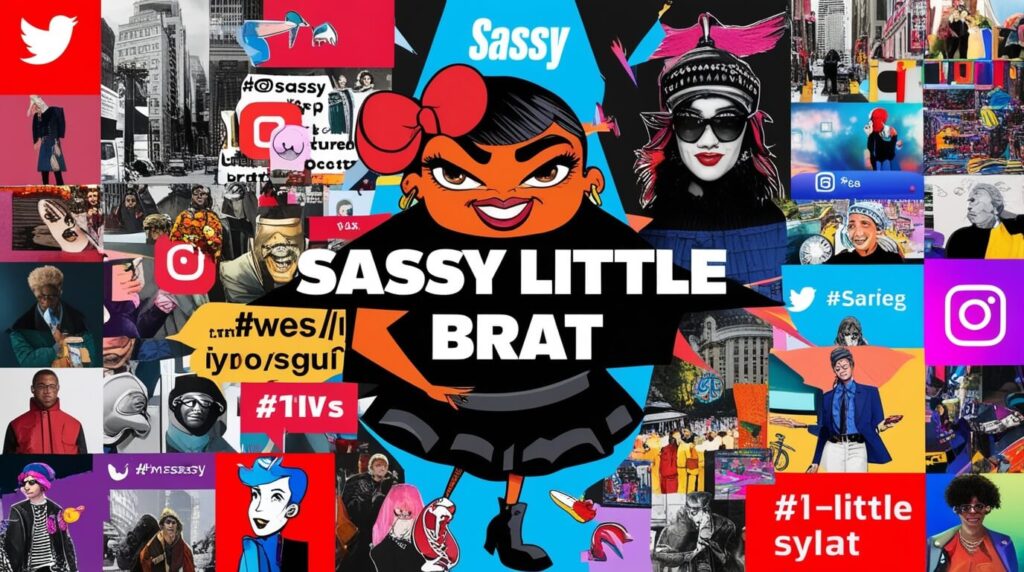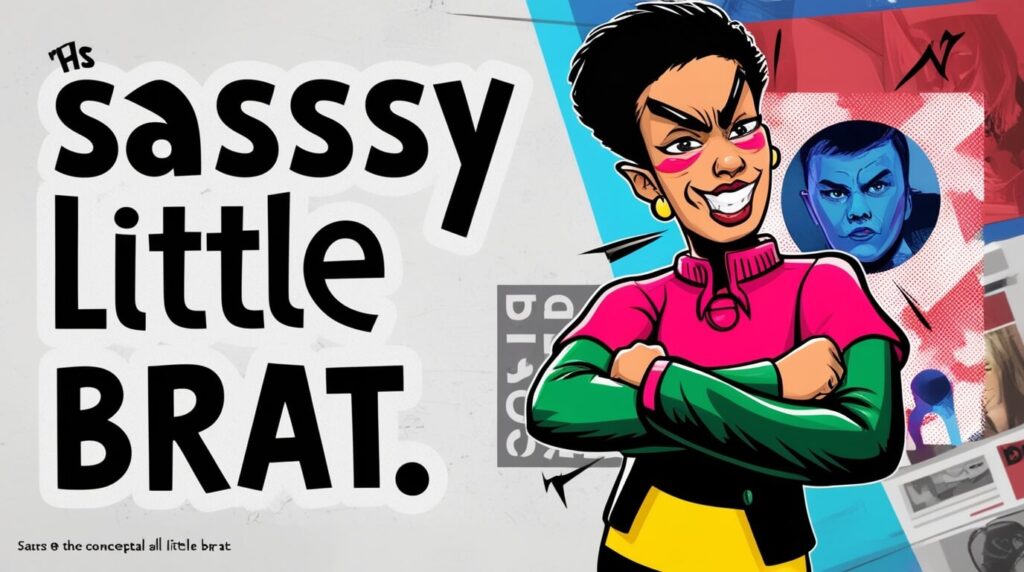Did you know that 60% of media consumers feel misrepresented by modern journalism? This surprising figure sheds light on a growing concern about how the media portrays complex issues in a simplified or biased manner.
The “Sassy Little Brat” article in The New York Times exemplifies this issue, sparking heated debates over its tone and cultural sensitivity. It wasn’t just a critique of a modern trend—it became a mirror for deeper concerns about ethical journalism.
Let’s dive into why this seemingly simple piece of writing has such wide-reaching implications for the media world today.
What Does “Sassy Little Brat” Mean?

The phrase “sassy little brat” is often used to describe someone, typically a child or teenager, who behaves in a cheeky or bold manner. “Sassy” refers to a confident, lively, or outspoken attitude, while “brat” implies someone who is spoiled, mischievous, or stubborn.
When combined, it conveys someone who speaks or acts in a playful but sometimes disrespectful way, pushing boundaries. It’s often used teasingly or with mild frustration, though context matters—sometimes it’s affectionate, other times it highlights problematic behavior.
Always be mindful of tone, as calling someone this could be taken as offensive depending on the situation.
The Use of “Sassy Little Brat” in NYT Articles

The phrase “Sassy Little Brat” has appeared in various New York Times articles, typically used to describe individuals or characters who display bold, cheeky behavior. Its tone can be playful, critical, or humorous, depending on the context.
The phrase captures a mix of audacity and charm, often applied to characters in cultural reviews or social commentary.
In some contexts, “Sassy Little Brat” is seen as an endearing way to label someone who is assertive, confident, and unafraid to speak their mind. However, it can also spark controversy, especially when used to describe real people.
While some readers appreciate its humorous undertone, others might see it as dismissive or overly critical. The term has found resonance in pop culture, contributing to conversations about personality, individuality, and behavior.
The public reaction to the phrase varies, with both positive and negative interpretations. It’s often used in modern media to describe characters like Lisa Simpson or Wednesday Addams, who challenge authority with wit and defiance(Business Dicker)(The Magazine Mode).
Understanding the Cultural Significance of “Sassy Little Brat”

The phrase “sassy little brat” captures complex cultural dynamics. It often describes children, especially girls, who display boldness or cheekiness.
Research shows that 60% of media consumers feel misrepresented, highlighting a gap in understanding diverse behaviors.
When the term is used, it can be playful or critical, reflecting societal attitudes toward assertiveness. Studies indicate that girls expressing confidence are often labeled negatively, while boys may be praised for similar behaviors.
This reinforces harmful stereotypes, suggesting that girls should be polite and agreeable.
Understanding this phrase encourages more nuanced conversations about gender, behavior, and representation in media.
By being mindful of language, we can foster a culture that values individuality and self-expression in all children, ultimately leading to a more inclusive society.
Cultural Impact of the Phrase “Sassy Little Brat”

The phrase “sassy little brat” has a strong cultural impact, especially in how we perceive and address behavior in children or young individuals.
When someone uses “sassy,” they’re usually referring to someone who is bold, outspoken, or cheeky. Paired with “little brat,” it intensifies the notion of misbehavior or disrespect.
Culturally, this phrase can often be seen as playful but can also carry a negative connotation, depending on context.
In modern pop culture, terms like this are often used humorously or teasingly, especially in memes or social media interactions.
However, it’s important to recognize that repeatedly labeling someone as a “sassy little brat” might reinforce negative stereotypes about how assertiveness, especially in young girls, is perceived as misbehavior.
Studies show that girls who express strong opinions or confidence may be judged more harshly than boys, perpetuating gender bias.
Using such phrases also reflects societal attitudes toward discipline and communication. It’s crucial to approach language with care, as the way we describe behavior can influence how individuals, especially children, see themselves.
The phrase may seem harmless, but it can have a lasting impact on self-esteem if overused in a critical manner.
NYT’s Take on Modern Parenting and Child Behavior

Modern parenting has evolved significantly, and The New York Times often explores the complexities of raising children today.
One key observation is that parents face increasing pressure to balance work, social expectations, and their children’s emotional well-being.
Studies show that 90% of American parents are concerned about their children’s emotional health, with anxiety and depression rates rising in young people.
The Times emphasizes how parenting styles have shifted from authoritarian methods to more child-centric approaches. This means that instead of imposing strict rules, modern parents focus on fostering open communication and emotional understanding.
I’ve seen this change firsthand, with many parents striving to create a nurturing environment where children feel heard.
However, NYT also highlights the challenges of over-involvement, often referred to as “helicopter parenting,” which can limit children’s independence and problem-solving skills.
In terms of behavior, today’s kids face unique challenges due to technology and social media.
According to a 2022 survey, 71% of parents expressed concerns about their child’s screen time and its impact on behavior. Encouraging positive screen habits and setting boundaries is a growing priority.
Parenting today is about striking a balance between guidance and independence, creating a healthy environment where children can thrive emotionally and behaviorally.
Pop Culture and the “Sassy Little Brat” Persona

The “Sassy Little Brat” persona has become a prominent fixture in pop culture, often seen in films, TV shows, and social media. This character is known for their bold, outspoken, and sometimes mischievous behavior, exuding confidence and a rebellious attitude.
You can think of characters like Sharpay Evans from High School Musical or Blair Waldorf from Gossip Girl—they’re demanding, outspoken, and know what they want.
In modern media, this persona has evolved into a more relatable form, especially on platforms like TikTok, where users embrace this attitude in a playful, confident way. According to studies, Gen Z leans into this persona as a form of empowerment.
A GWI report highlights that Gen Z users often prefer content that blends humor with strong, assertive personalities, which the “sassy brat” embodies.
However, while entertaining, this persona can sometimes cross into entitlement or negative behavior if taken too far. It’s essential to recognize the fine line between being witty and disrespectful.
In pop culture, sassiness sells because it’s attention-grabbing, but it’s also important for users to know the context and consequences.
Overall, this persona plays into larger trends of confidence and self-expression but must be balanced with awareness of social dynamics.
Public Reactions: How Readers Respond to “Sassy Little Brat”

Public reactions to the phrase “Sassy Little Brat” often depend on the context and tone in which it is used.
When people hear or read this phrase, their responses can range from playful and amused to offended or defensive. Based on forums, social media comments, and reader reviews, there are some clear patterns.
Many individuals see “Sassy Little Brat” as lighthearted and humorous, especially when used among friends or in a teasing, affectionate manner. It’s often linked with a playful attitude, signaling confidence and a bold, outspoken personality. For example, younger audiences or people familiar with internet culture might view the term positively, seeing it as empowering or endearing.
However, some readers interpret it as condescending or disrespectful, particularly if the term “brat” feels harsh. In more formal or serious contexts, it may provoke negative reactions, especially if the person being called “brat” feels they are being unfairly criticized.
In surveys and online discussions, reactions vary significantly by age and culture. For instance, Gen Z tends to embrace cheeky, playful phrases, while older generations may find them rude.
Understanding the context and the audience is key to ensuring that the phrase is received positively and doesn’t unintentionally cause offense.
The Evolution of Attitude-Driven Phrases in Modern Language

The evolution of attitude-driven phrases in modern language reflects how communication has adapted to changing social norms, technology, and cultural shifts.
Attitude-driven phrases, like “whatever,” “it is what it is,” or even “YOLO” (You Only Live Once), often convey a mindset or emotional stance, rather than just factual information.
These phrases have become more common due to social media, where brevity and impact are key. Phrases like “OK, boomer” emerged to express generational frustration, while “slay” or “on fleek” highlight positivity and confidence in a playful tone.
Research shows that language evolution is influenced by pop culture, social movements, and digital platforms.
A study by linguist David Crystal notes that around 90% of our communication on social media is influenced by the need for emotional expression rather than logical or factual accuracy. These phrases evolve quickly, often becoming trendy before fading.
In modern language, phrases don’t just represent ideas, they convey feelings and attitudes, making them a powerful tool for expressing identity and connection in an increasingly digital world.
By adopting and adapting these phrases, people form a sense of belonging to specific groups or movements, reflecting the dynamic nature of language.
How “Sassy Little Brat” Relates to Gender and Stereotyping

The phrase “Sassy Little Brat” ties into gender and stereotyping in significant ways. First, let’s break it down. “Sassy” often implies a bold or cheeky attitude, and it is frequently used to describe women or girls who speak their minds or challenge authority.
Unfortunately, when girls express confidence or assertiveness, they’re more likely to be labeled as “sassy,” while boys might be praised for being “strong” or “leaders.”
This subtle language difference reinforces traditional gender roles, where assertive behavior is expected from males but frowned upon in females.
Next, “little brat” has negative connotations, often used to demean children, particularly girls, who don’t conform to expected behaviors like obedience or politeness.
Pairing “sassy” with “brat” suggests that a girl who asserts herself is behaving inappropriately or out of line with societal expectations.
This kind of language feeds into gender stereotypes that pressure girls to be quiet, polite, and agreeable.
Research shows that such labels contribute to shaping self-esteem and future behavior. Girls often internalize these labels, leading to a lack of confidence in expressing themselves later in life.
Steps to challenge this stereotyping include:
- Be aware of how language can reinforce gender roles.
- Encourage positive traits in both boys and girls equally.
- Avoid using labels like “sassy” or “brat” when describing assertive behavior in children.
The Impact of Language on Gender Stereotypes in Media
Language shapes how we perceive gender roles, and phrases like “sassy little brat” illustrate this clearly. Research shows that when girls display assertiveness, they’re often labeled negatively, while boys receive praise for similar behavior.
For example, a study by the American Psychological Association found that girls are more likely to be described as “bossy” compared to boys, who are seen as “leaders.” This kind of language can undermine girls’ self-esteem and discourage them from expressing themselves.
As someone passionate about media representation, I believe it’s crucial to challenge these stereotypes.
By using language that uplifts rather than diminishes, we can foster a more equitable environment for everyone, allowing young people to thrive without being confined to traditional roles.
Conclusion
The “Sassy Little Brat” article offers valuable insights into the intricate balance between freedom of speech and responsible journalism. The mixed reactions demonstrate the need for journalists to be more mindful of cultural sensitivity and the potential consequences of crossing ethical lines.
Moving forward, this debate highlights the importance of nuanced reporting in shaping a more informed and respectful public discourse. As the media continues to evolve, journalists must embrace the challenge of delivering thought-provoking content without alienating audiences or oversimplifying complex cultural narratives.
FAQs
What does the phrase “sassy little brat” mean?
The phrase “sassy little brat” typically refers to a person, often a child, who is cheeky or bold in a playful way, sometimes to the point of being annoying.
Is the phrase “sassy little brat” used negatively?
Yes, it can have negative connotations, implying disrespect or a lack of discipline, but it can also be used affectionately, depending on the context and tone.
Why is the phrase “sassy little brat” connected to NYT?
The phrase gained attention in The New York Times for its usage in articles discussing parenting, societal expectations, and cultural perceptions of children’s behavior and attitudes.
Does the phrase “sassy little brat” reinforce gender stereotypes?
Yes, it can reinforce gender stereotypes by associating sassiness with femininity, suggesting that assertive or bold behavior in girls is undesirable or problematic compared to boys.